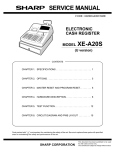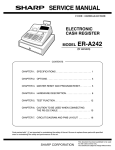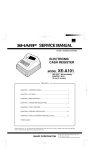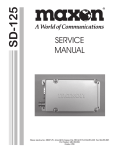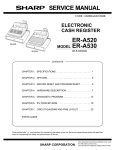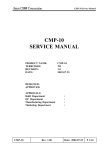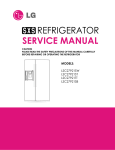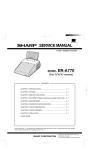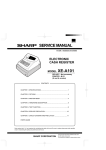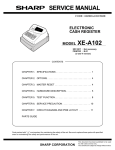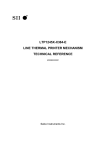Download Sharp XE-A201 Service manual
Transcript
Top and Bottom of a Page : -38.1mm XE-A201US q SERVICE MANUAL CODE : 00ZXEA201USME ELECTRONIC CASH REGISTER MODEL XE-A201 SRV KEY : Not necessary PRINTER : M-T51 (U and A version) CONTENTS CHAPTER 1. SPECIFICATIONS...................................................................... ..... 1 CHAPTER 2. OPTIONS......................................................................................... 5 CHAPTER 3. MASTER RESET AND PROGRAM RESET.................................... 5 CHAPTER 4. HARDWARE DESCRIPTION........................................................... 6 CHAPTER 5. TEST FUNCTION............................................................................12 CHAPTER 6. IPL (INITIAL PROGRAM LOADING) FUNCTION...........................15 CHAPTER 7. CIRCUIT DIAGRAM AND PWB LAYOUT.......................................17 PARTS GUIDE Parts marked with "!" are important for maintaining the safety of the set. Be sure to replace these parts with specified ones for maintaining the safety and performance of the set. SHARP CORPORATION This document has been published to be used for after sales service only. The contents are subject to change without notice. XE-A201US CHAPTER 1. SPECIFICATIONS ■ Machine state symbols 1. APPEARANCE Rear view Front view Customer display (Pop-up type) Operator display Printer cover P: Appears during programming. E: Appears when an error is detected. o: Appears when the subtotal is displayed or when the amount tendered is smaller than the sales amount. c: Appears when the [CONV] key is pressed to calculate a subtotal in foreign currency. F: Appears when a transaction is finalized by pressing the [CA/AT/ NS], [CHK] or [CH] key. C: Appears when the change due amount is displayed. Receipt paper Power cord Mode switch Keyboard Drawer lock E-E : May appear in the far-left three positions at the timing of key entry when the electronic journal (EJ) memory is full. (Depending on programming.) RS-232C connector Drawer L: Appears when the voltage of the installed batteries is under the required level. You must replace with new ones within two days. L: Appears when the batteries are not installed, or the installed batteries are dead. You must replace with new ones immediately. •: May appear right below the eighth and ninth places at the timing of finalization of a transaction when the electronic journal (EJ) memory is nearly full. Also appears right below the tenth place when power save mode is effective. H: Appears when the print head release lever is in the lifted position. 2. RATING XE-A201 Weight 16.8lb (7.6kg) Dimensions 330 (W) x 428 (D) x 280 (H) mm 13.0 (W) x 16.9 (D) x 11.0 (H) inches Power source AC 120V (m10%), 60Hz Power consumption Stand-by 7W, Operating 34.5W (max.) Working temperature 0°C~40°C (32°F to 104°F) 3. KEYBOARD PPPPPPPPPP : Appears when the paper is out. 2) KEY LIST 1) KEYBOARD LAYOUT ■ Keyboard layout Type Normal keyboard Key position STD/MAX 53 Key pitch 19 (W) x 19 (H) mm Key layout CONV RA %1 Fixed type RCPT /PO – Customer display (Pop-up type) Operator display DC Clerk code SHIFT ESC BS DC SHIFT NUMBER SPACE 7 8 4 5 1 2 0 CL 9 6 3 00 PLU /SUB 4 DEPT # DEPT SHIFT A F K P 20 24 28 32 B 8 19 3 C 7 18 2 D E 12 H 6 I 11 J 16 M 10 N 15 O R 30 14 25 9 Q 31 26 21 5 L 27 22 17 1 G 23 CLK# S 29 13 T TAX AUTO U X TAX1 SHIFT TAX2 SHIFT V Y CHK CH W Z MDSE SBTL #/TM SBTL CA/AT/NS Note: The small characters on the bottom or lower right in each key indicates functions or characters which can be used for character entries for text programming. Amount: Appears in the far-right eight (max.) positions. When the amount is negative, the minus symbol “-” appears before the amount. Number of repeats for repetitive registrations: The number of repeats is displayed, starting at “2” and incremental with each repeat. When you have registered ten times, the display will show “0.” (2 3 3 ..... 9 3 0 3 1 3 2 ... ) Receipt function status: The indicator “_” appears in the RCPT OFF position when the receipt function is in the OFF status. Time: NUMBER VOID RFND PLU/SUB DEPT REPEAT RCPT OFF %2 • @/FOR Appears in the far-right six positions (hour-minute - ”A” or hour-minute - ”P”) in the OP X/Z, REG, or MGR mode. “A” is displayed in the morning (AM), and “P” in the afternoon (PM). In the REG or MGR mode, press the [#/TM/SBTL] key to display the time. –1– XE-A201US ■ Key names The mode switch has these settings: KEY TOP OFF: DESCRIPTION 2 Paper feed key RA OP X/Z: To take individual clerk X or Z reports, and to take flash reports. Received-on account key RCPT/PO Receipt print/Paid-out key VOID It can be used to toggle receipt state “ON” and “OFF” by pressing he [RCP/PO] key. Void key ESC This mode locks all register operations. (AC power turns off.) No change occurs to register data. Escape key REG: For entering sales. CONV Conversion key PGM: To program various items. %1, %2 Percent 1and 2 key VOID: Enters into the void mode. This mode allows correction after finalizing a transaction. MGR: For manager’s entries. The manager can use this mode for an override entry. RFND Refund key - Discount key @/FOR Multiplication key n CL 0-9,00 Decimal point key X1/Z1: To take the X/Z report for various daily totals. Clear key X2/Z2: To take the X/Z report for periodic (weekly or monthly) consolidation. Numeric Keys PLU/SUB PLU/Subdepartment key DEPT# Department code entry key DEPT SHIFT Department shift key CLK# Clerk code entry key Dept1-32 5. DISPLAY 1) OPERATOR DISPLAY Department keys TAX Tax key Tax 1 SHIFT Tax 1 shift key Tax 2 SHIFT Tax 2 shift key AUTO Charge key MDSE SBTL : 1 line Color of display Check key CH : LED numeric display Number of line Number of positions : 10 positions numeric display Automatic sequence key CHK Display device : Yellow / Green Character form : 7 segment + DP Character size : Numeric 14.2 (H) x 7.9 (W) mm Layout: Merchandise subtotal key #/TM/SBTL Non-add code/Time display/Subtotal key CA/AT/NS Total/Amount tender/Non Sale key 0 . 1 . 2 . 3 . 4 . 5 . 6 . 7 . 8 . 9 . 2) CUSTOMER DISPLAY 4. MODE SWITCH Display device : LED Number of line : 1 line 1) LAYOUT Number of positions : 7 positions • Rotary type Color of display : Yellow / Green Style : Pop up type Manager key (MA) MA MA OP VOID Operator key (OP) : 14.2mm (H) x 7.9mm (W) 3 . 4 . 5 . 6 . 7 . 8 . 9 . X2/Z2 OP PGM MGR X1/Z1 : 7 segment + Dp Character size Layout: REG OPX/Z OFF Character form The mode switch can be operated by inserting one of the two supplied mode keys - manager (MA) and operator (OP) keys. These keys can be inserted or removed only in the “REG” or “OFF” position. –2– XE-A201US Segment • Print speed : Approximate 52mm/s (Approximate 10 l/s) • Paper feed speed : Approximate 52mm/s (Approximate 10 l/s) Display position Description (Manual feed) : Approximate 52mm/s (Approximate 10 l/s) Amount 1-8 Minus sign 2-10 -: Floating Error 8-10 Exx:xx = error code • Paper end sensor : Set up • Reliability : Mechanism LIFE 6 million lines used to highquality thermal paper PGM Mode 10 P • Cutter CASH, CHECK, CHARGE 10 F: Light up when a registration is finalized by depressing CASH, CHECK, CHARGE key • Near end sensor : No : Manual Cutter SUB TOTAL/ short tender 10 o Change 10 C: Light up whenever the change due amount appears in the display. Currency Conversion 10 c: Light up whenever the foreign amount appears in the display. Department 9-10 PLU 7-10 2) Paper • Paper roll dimension : 57.5 m 0.5mm in width Max. 80mm in diameter • Paper quality No zero-suppressed : High-quality thermal paper paper thickness: 0.06 to 0.08mm Nihon seisi thermal paper : TF50KS-E Oji thermal paper : PD150R, PD160R No zero-suppressed Repeat 8 Endless count, starting from 2. 3) Logo stamp Receipt OFF 9 _ • No DC _: Double size character entry status SHIFT _: Shift character entry status NUMBER _: Number character entry status Clerk No. 2, 3 -xx-: clerk number EJ FULL 8-10 E-E: Light up when EJ memory is FULL at the timing of key entry (by PGM selection). Low Battery 10 L: No Battery 10 L: 4) Printing area Number of thermal head heater elements 288 dots (4.75) 48 (288 dots) (4.75) print area (max.24 characters) 0.167 Decimal Point Display position Decimal point 7-1 TAB 4-1 EJ near full 8, 9 Description 57.5±0.5 (Paper dimension) (by PGM selection) 6. PRINTER 1) Printer • Part number : M-T51 • NO. of station : 1 (Receipt of journal) • Validation : No. • Printing system : Line thermal • No. of dot : 288 dots • Dot pitch : Horizontal 0.167mm Vertical 0.174mm • Font : 10 dots (W) u 24 dots (H) • Printing capacity : max. 24 characters • Character size : 1.67mm (W) u 4.17mm (H) at 10 u 24 dots • Print pitch : Column distance Row distance 2.0mm 5.21mm –3– (units : mm) XE-A201US 7. DRAWER 8. BATTERY [OUTLINE] 1) MEMORY BACK UP BATTERY • Standard equipment: Yes (1) For memory back up, the dry battery AA (3 pieces) are needed. • Max. number of additional drawers: 1 1. Memory holding time: Approx. 1 year after New dry batteries are installed. • The drawer consists of: 2. Battery exchange method: 1) Drawer box (outer case) and drawer When the low battery symbol “L” lights up, replace the batteries (3 AA) by the following method; 2) Money case 3) Coin case 1) Power on the ECR. 4) Lock (attached to the drawer) 2) Mode switch turn to “REG” mode. 3) Remove the OLD dry batteries (3 pieces). [SPECIFICATION] 4) Insert the NEW dry batteries (3 pieces). 1) DRAWER BOX AND DRAWER 5) Confirm the low battery symbol “L” is off. Model name of the drawer box SK415 Size 330 (W) x 418 (D) x 98 (H) mm 13 (W) x 16.5 (D) x 3.9 (H) inches Material Metal Bell – Release lever Standard equipment: situated at the bottom Drawer open sensor – Separation from the main unit 2) LOW BATTERY Low battery indication will appear on the left side of display when the battery voltage is low. CASE 1: The machine can indicate the low battery condition. (Always) CASE 2: 2) MONEY CASE Disallowed Separation of the bill compartments from the coin compartments Allowed Bill separator – Number of compartments 4B/5C When numeric entry or item entry is done. Battery condition will not appear. Exceptionally, when the power is restored after a power failure, the low battery condition will appear on the display only when the battery is low. And the indicator will disappear after any key entry. – Separation from the drawer When any numeric entry & any item entry is not done or just after finalization. [Display sample] “ “L “L 0.00” : Battery is OK. 0.00” : Low battery (You have to change the batteries.) 0.00” : No battery (You have to change the batteries immediately.) After finalization Layout: “F “L “L 12.34” : Battery is OK. 12.34” : Low battery. (“L” indicate instead of “F”.) 12.34” : No battery. (“L” indicate instead of “F”.) Note: “NO BATTERY”: When the “NO BATTERY” is display, the master reset is executed at the timing of “POWER ON” after the “POWER OFF”. 4B/5C 3) LOCK (LOCK KEY : LKGIM7331BHZZ) • Location of the lock: Front • Method of locking and unlocking: To lock, insert the drawer lock key into the lock and turn it 90 degrees counter clockwise. To unlock, insert the drawer lock key and turn it 90 degrees clockwise. ck unlo Lo SK1-1 SK1-1 • Key No: ck –4– XE-A201US CHAPTER 2. OPTIONS 1. OPTIONS (No) 2. SERVICE OPTIONS (No) 3. SUPPLIES NO 1 PARTS CODE PRICE RANK TPAPR6656RC05 BA PARTS CODE PRICE RANK BU NAME Thermal roll paper DESCRIPTION 5 ROLLS/PACK 70 φ 4. SPECIAL SERVICE TOOLS NO NAME 1 RS-232 Loop-back connector UKOK-6705RCZZ 2 POS tools (IPL Software) UKOG-2360BHZZ DESCRIPTION CHAPTER 3. MASTER RESET AND PROGRAM RESET 1. MASTER RESETTING 2. PROGRAM RESETTING (INITIALIZATION) Master resetting clears the entire memory and resumes initial values. Master resetting can be accomplished by using the following procedure: This resetting resumes the initial program without clearing memory. Procedure A: Procedure: This resetting can be operated at below sequence in PGM mode. 1) Plugin the AC cord to the wall outlet. 1) Unplug the AC cord from the wall outlet. 2) Set the mode switch to REG position. 2) Wait over 1 muinite for discharging. 3) Let the ECR be witout the memory backup battery. 3) Set the mode switch to the PGM position. 4) Unplug the AC cord from the wall outlet. 4) While holding down the FEED key, plugin the AC cord to the wall outlet. 5) Wait over 1 minute for discharging. Note: In case power failure occurs when the machine has no battery attached to it, the master reset operation is automatically performed after the power has been restored. 6) Plugin the AC cord to the wall outlet. The master reset can also be accomplished in the following case. In case power failure occurs when the machine has no battery attached to it, the master reset operation is automatically performed after the power has been restored. (This is because if power failure occurs with no battery attached to the machine, all the memories are lost and the machine does not work properly after power recovery; this requires the master reset operation.) –5– XE-A201US CHAPTER 4. HARDWARE DESCRIPTION 1. HARDWARE BLOCK DIAGRAM POWER SUPPLY STANDARD DRAWER. CPU Data bus DRIVER , SENSOR ROM : 256K Byte RAM : 20K Byte RAM Address bus 128K Byte POPUP Seg. DRIVER PRINTER M-T51 FRONT LED 4 to 16 DECORDER Dig. DRIVER PAPER TAKE UP MOTOR KEYBOARD MODE SWITCH KEY SCAN SIGNAL KEY RETURN SIGNAL RS232C DRIVER RS232 –6– XE-A201US 2) Pin description TRANSFORMER PQ1CG2032 V0 24V Drawer Pin No. /POFF detect point PQ1CG2032 VLED 5.7V VCC 5V VDD 5V Battery Function 1 SOUT4 P96 In 2 CLK4 P95 In Key IN Key IN 3 TB4IN P94 In Key IN 4 TB3IN P93 In Key IN 5 SOUT3 P92 In Key IN 6 SIN3 P91 In Key IN 7 CLK3 P90 In Key IN VDD BYTE VDD In 9 CNVss CNVss In Normal : L VH, VP (8V) PRINTER HEAD, MOTOR PAPER TAKEUP MOTOR 10 XCIN XCIN In Calender clock :32.768KHz 11 XCOUT XCOUT In Calender clock :32.768KHz 12 /RESET /RESET 13 XOUT XOUT 2. DESCRIPTION OF MAIN LSI’S 2-1. CPU (M30624FGAFP) SIN4 AVCC VREF AN0 AVSS AN1 AN2 AN3 AN4 AN5 AN6 AN7 D0 D1 D2 D3 D4 D5 D6 D7 D8 D9 D10 D11 D12 100 99 98 97 96 95 94 93 92 91 90 89 88 87 86 85 84 83 82 81 80 79 78 77 76 P97 VDD VDD TH GND P101 Vref P103 P104 P105 LATCH DTS D0 D1 D2 D3 D4 D5 D6 D7 P10 P11 P12 P13 PH1 1) Pin configuration M30624FGAFP D13 D14 D15 A0 A1 A2 A3 A4 A5 A6 A7 VSS A8 VCC A9 A10 A11 A12 A13 A14 A15 A16 A17 A18 A19 75 74 73 72 71 70 69 68 67 66 65 64 63 62 61 60 50 58 57 56 55 54 53 52 51 PH2 PH3 PH4 A0 A1 A2 A3 A4 A5 A6 A7 GND A8 VDD A9 A10 A11 A12 A13 A14 A15 A16 A17 NC NC P74 P73 CLK P71 DAT P67 P66 /FRES P64 FSD FRD FSCK DR1 /RDY /HOLD VCC NC NC /RD NC /WR /CS3 /RAS1 BUSY /ROS1 26 27 28 29 30 31 32 33 34 35 36 37 38 39 40 41 42 43 44 45 46 47 48 49 50 TA2OUTW TA1IN/V TA1OUT/V TB5IN TB5OUT TXD1 RXD1 CLK1 CLKS1 TXD0 RXD0 CLK0 /RTS0 /RDY ALE /HOLD /HLDA CBCLK /RD /BHE /WR /CS3 /CS2 /CS1 /CS0 SOUT4 CLK4 TB4IN TB3IN SOUT3 SIN3 CLK3 BYTE CNVss XCIN XCOUT /RESET XOUT Vss XIN Vcc NMI INT2 INT1 INT0 TA4IN/U TA4OUT/U TB3IN TBEOUT TA2INW In/ Out 8 ON/OFF Control (MODE SW, /POFF, CPU P105) 1 2 3 4 5 6 7 8 9 10 11 12 13 14 15 16 17 18 19 20 21 22 23 24 25 SIGNAL NAME ON/OFF Control (MODE SW) LM2574 + Tr. P96 P95 P94 P93 P92 P91 P90 VDD GND XCIN XCOUT /RESET XOUT GND XIN VDD VDD CTCRL /FRDY P-OFF MOTOR BUZ1 P77 P76 P75 SYMBOL –7– In Reset Out Open Booting : H 14 Vss Vss In Vss 15 XIN XIN In System clock 16 Vcc VDD In VDD 17 NMI P85 In Not used 18 INT2 P84 Out PRINTER/STB2 19 INT1 /RDY In NU FMC (/RDY) 20 INT0 P-OFF 21 TA4IN/U MOTOR Out In Paper take up motor drive 22 TA4OUT/U BUZ1 Out Buzzer drive 23 TB3IN P77 In RS232 :DR 24 TBEOUT P76 In RS232 :CS 25 TA2INW P75 In RS232 :CD 26 TA2OUTW P74 Out RS232 :ES 27 TA1IN/V P73 Out Drawer drive 2 28 TA1OUT/V CLK2 Out Printer data clock 29 TB5IN P71 Out NU FMC (BUSY) 30 TB5OUT TXD2 Out Print data 31 TXD1 P67 Out RS232 :SD 32 RXD1 P66 In RS232 :RD 33 CLK1 /FRES Out NU FMC (/FRES) 34 CTS1/RTS1 P64 Out RS232 :RS 35 TXD0 FSD Out FMC :Send data 36 RXD0 FRD 37 CLK0 FSCK Out FMC :Shift clock 38 /RTS0 DR1 Out Drawer drive 1 39 CLKOUT /RDY In 40 ALE NC 41 /HOLD /HOLD 42 /HLDA NC Out NOT USE 43 CBCLK BCLK Out BCLK 44 /RD /RD Out Read 45 /BHE NC Out NOT USE 46 /WR /WR Out Write 47 /CS3 CS3 Out Display segment latch 48 /CS2 /CS2 Out Chip select :for RAM 49 /CS1 /CS1 Out EPM Control 50 /CS0 /CS0 Out Chip select :for ROM 51 A19 A19 Out Address bus :19 52 A18 A18 Out Address bus :18 In Out In Power off FMC :Receive data /RDY (CGROM) NOT USE /BOOT MODE XE-A201US Pin No. SYMBOL SIGNAL NAME In/ Out 53 A17 A17 Out Address bus :17 54 A16 A16 Out Address bus :16 55 A15 A15 Out Address bus :15 56 A14 A14 Out Address bus :14 57 A13 A13 Out Address bus :13 58 A12 A12 Out Address bus :12 59 A11 A11 Out Address bus :11 60 A10 A10 Out Address bus :10 Out 61 A9 A9 62 VCC VDD 63 A8 A8 64 VSS VSS 65 A7 A7 Out Address bus :7 66 A6 A6 Out Address bus :6 67 A5 A5 Out Address bus :5 68 A4 A4 Out Address bus :4 69 A3 A3 Out Address bus :3 70 A2 A2 Out Address bus :2 71 A1 A1 Out Address bus :1 72 A0 A0 Out Address bus :0 73 P17 ENA2 Out Paper feed motor :ENA2 74 P16 ENA1 Out Paper feed motor :ENA1 75 P15 IN2 Out Paper feed motor :IN2 76 P14 IN1 Out Paper feed motor :IN1 77 P13 P13 Out Key/Display 78 P12 P12 Out Key/Display 79 P11 P11 Out Key/Display 80 P10 P10 Out Key/Display 81 D7 D7 InOut Data bus :7 82 D6 D6 InOut Data bus :6 In Out In 3. CLOCK GENERATOR Function 1) CPU 15 XIN 13 XOUT 12MHz CPU Address bus :9 R 330 11 XCOUT VDD X1 32.768KHz Address bus :8 10 XCIN VSS 83 D5 D5 InOut Data bus :5 84 D4 D4 InOut Data bus :4 85 D3 D3 InOut Data bus :3 86 D2 D2 InOut Data bus :2 87 D1 D1 InOut Data bus :1 88 D0 D0 InOut Data bus :0 89 AN7 STB1 Out Printer head strobe 90 AN6 LATCH Out Printer data latch 91 AN5 P105 Out Printer head voltage ON 92 AN4 P104 Out CG ROM Bank 93 AN3 P103 In 94 AN2 Vref In NU Vret 95 AN1 P101 In Printer head voltage check 96 AVSS VSS In VSS 97 AN0 TH In Print head temperature check C 18P C 27P Two oscillators are connected to the CPU. The basic clock X2 is supplied from a 12MHz oscillator. If the CPU was not operating properly, the signal does not appear on this line in most cases. The sub-clock X1 generates 32.768KHz which is primarily used to update the internal RTC (real time clock). During the standby mode, it keeps oscillating to update the clock and monitoring the power recovery. 4. RESET CIRCUIT VDD MODE SWITCH SRV' position VDD IC S-80928ANMP R CPU R 11 R C /RESET C (1) When the mode switch is placed in the “SRV” position, the reset signal is sent to the CPU to reset the hardware. (2) When VDD t 2.8V, a reset signal is outputted from the reset IC. (S-80928ANMP) VBAT 5. P-OFF CIRCUIT VCC R15 2.7K VLED R16 9.1KG R20 2.7K R19 98 VREF VDD In VDD 99 AVCC VDD In VDD C14 1uF/50V R17 56K 0 3 8 5 8 7 1 100 SIN4 P97 In Key IN R18 IC4A BA10393 4 3.9K ZD4 MTZJ5.1B –8– /POFF 6 2 IC4B BA10393 4 C15 0.1uF P-OFF XE-A201US The P-OFF signal detects two signals by two comparators and sent to the CPU. 7. PRINTER CONTROL CIRCUIT V0 (24V) signal: If the power voltage V0 (24V) falls bellow the specified level, the P-OFF signal is driver to LOW by the comparator ICAA. 1) Paper feed motor circuit VLED signal: VH If the LED/Logic power voltage VLED falls below the specified level, the P-OFF signal is driven to LOW by the comparator IC4B. VCC CPU PH1 PH3 PH2 6. MEMORY CIRCUIT A /A B /B IC13 PH4 MOTOR LB1838M 1) Address map 00000h Stepping motor control 00400h The 2-phase, bi-polar stepping motor is driven at a constant voltage by LB1838M (made by SANYO). CPU internal RAM 20kbytes 05400h 1 step: 0.087mm 1 dot: 2 steps CPU port 06000h /CS3 area 06000h - 07FFFh Segment latch address No. CPU port Signal used 76 P14 IN1 75 P15 IN2 74 P16 ENA1 73 P17 ENA2 08000h External S-RAM : 128kbytes /CS2 area 08000h - 27FFFh (128kbytes area) 28000h 40000h Drive step Driver IC input (CPU output) STEP C0000h CPU internal ROM 256kbytes IN1 IN2 ENA1 Motor drive signal ENA2 A B /A /B (OUT1) (OUT3) (OUT2) (OUT4) 1 L L H H H H L 2 H L H H L H H L L 3 H H H H L L H H 4 L H H H H L L H FFFFFh 2) Print circuit 2) RAM control Thermal head configuration As shown in the equivalent circuit in the figure, thermal head consists of heating elements and head drivers which drives and controls those heating elements. Power supply circuit or Dry battery The serial print data input through the DATA IN (D1) is transferred to the shift register synchronizing with the CLOCK (CP) and stored in the latch register by the LATCH (LA) signal. CS2 A0-A16 A0-A16 A0-A16 VCC D0-7 D0-7 VDD /CS2 VDD The head conduction signals (print commands 1 ~ 6) turn the gate on to conduct the heating element corresponding to the print data. I/O0-7 /CS2 /CS1 S-RAM CPU VCC /RD VCC /WR /RD /WR 128K byte IC /OE /WE –9– XE-A201US 9. DRAWER DRIVE CIRCUIT Thermal head block daigram Dot #288 Dot #1 V0 5,6,18,19 VP FB2 9,10,14,15 GND C80 CPU CN5 11 STB1 13 (38pin) LAT 16 Shift register MOTOR Q9 STB2 7 Latch register /RTS0 R102 DR1 CLK 17 When the DR1 signal from the CPU is HIGH, Q9 is turned on to operate the solenoid. DAT 12 VCC Connector 10. BUZZER DRIVE CIRCUIT Thermal head strobe terminals STB No. Dot No. Number of dots 1 1 ~ 144 144 2 145 ~ 288 144 VCC BZ BZ 470 8. PAPER TAKE UP MOTOR DRIVE CIRCUIT CPU VH TA4OUT/U 22pin C79 CPU CN5 TA4IN/U MOTOR MOTOR R101 Q13 (21pin) When the pulse signal (about 4KHz) is generated from the CPU, the buzzer sounds. When the MOTOR signal from the CPU is HIGH, Q1 is turned on to operate the motor. 11. KEYBOARD CIRCUIT P10-13 P10-13 HC138 /S0-9 /S0-7 /S0-9 P10-13 HC138 /S0-7 /S1 /S3 /S4 Paper feed key Head up sensor Paper end sensor /S8-9 Key Matrix Mode Switch /S0 - 9 /S9 RS232 /CI signal P92-97 P92-97 P90 CPU P91 P91 D0-7 /CS3 D0-7 G1',G2', G3'G4',G5', G6',G7 a,b,c,d,e,f,g,dp 74HC374 /CS3 Front display A',B',C',D',E',F',G',DP' Four P10-13 signals from the CPU are converted into 16 strobe signals by two 74HC138 for use in various functions. – 10 – Pop-up display XE-A201US 1) Keyboard 5) Paper end sensor Scan signal: Scan signal: 10 /S0-9 signals 1 /S4 signal Return signal: 6 P92-97 signals Return signal: 1 P91 signal The keys are read by the key matrix following the above signals. The paper end sensor state is read by the above signals. 2) Mode switch Scan signal: Receipt near end sensor Near end detected Near end not detected P91 Low High 8 /S0-7 signals Return signal: 1 P90 signal 6) RS232/CI signal detection The positions are read by the above signals. Scan signal: Scan signal /S0 /S1 /S2 /S3 /S4 /S5 /S6 /S7 Mode switch position SRV PGM (OFF) TIME REG MGR X1/Z1 X2/Z2 1 /S9 signal Return signal: 1 P91 signal The RS232/CI signal is detected by the above signals. 3) Paper feed key Scan signal: RS232 /CI signal /CI signal detected /CI signal not detected P91 Low High 7) Display 1 /S1 signal Scan signal: Return signal: 1 P91 signal 10 /S0-9 signals The above 10 scan signals are used as the following digit signals. The paper feed key is read by the above signals. Digit signal: 4) Head up sensor Scan signal /S0 /S1 /S2 /S3 Scan signal: Digit signal: G1’ Front G2’ G3’ G4’ G5’ G6’ G7’ G8’ G9’ G10’ Digit signal: G1’ Pop-up G2’ G3’ G4’ G5’ G6’ G7’ 1 /S3 signal Return signal: 1 P91 signal The Head up sensor state is read by the above signals. Head up sensor Head up detected Head up not detected Low High P91 /S4 /S5 /S6 /S7 /S8 Segment signal : Segment signals: a, b, c, d, e, f, g, and DP are output by the IC:74HC374, using the data bus signal:D0-7 from the CPU as an input signal and the chip select signal:/CS3 as a latch signal. 12. RS232 CIRCUIT P75 P66 P67 P74 R2OUT CD R2IN RD R1OUT T3IN T2IN R1IN SD T3OUT ER T2OUT HIN211 CPU P77 P64 P76 P91 /S9 R4OUT T1IN R5OUT R3OUT DR R4IN RS T1OUT CS R5IN R3IN CI 1 CD 2 RD 3 SD 4 ER 5 GND 6 DR 7 RS 8 CS 9 CI D-SUB 9pin connector /S5 The signals from the CPU are converted by the HIN211 into the RS232 level to input and output them. – 11 – XE-A201US CHAPTER 5. TEST FUNCTION 1. TEST ITEMS 2) KEY CODE 1 Key operation The test items are as follows: NO. Code 1 100 Display buzzer test 2 101 Key code 3 102 Printer test 4 104 Keyboard test 5 105 mode switch test 6 106 Printer sensor test 7 107 Clock display test 8 110 Drawer 1 open & sensor test 101 Description 9 120 External RAM test 10 121 CPU internal RAM test 11 140 CPU internal ROM test 12 160 AD conversion port test 13 500 RS232C test 14 550 Sleep mode test RCPT/PO 2 Test procedure Display KEY CODE 3 Check that: KEY code: Every time a key is pressed, the code of that key is displayed as a decimal number. When a key is pressed twice or pressed in an incorrect manner, --will be displayed. 4 End of testing You can exit the test mode by turning the mode switch to a position other than the SRV mode. The printer prints as follows: 101 3) PRINTER TEST 1 Key operation 102 2. DESCRIPTION OF EACH DIAGNOSTIC PROGRAM 2 Test procedure 1) DISPLAY BUZZER TEST Display 1 Key operation 100 2 Test procedure Display at front side 1.2.3.4.5.6.7.8.9.0. 4.5.6.7.8.9.0. 3 Check that: After that, all segments turn on (about 1 sec) Display at front side ----------------ZZZZZ ----------------ZZZZZ ----------------ZZZZZ 3 lines of 24 Z's are printed. The decimal point will shift in steps of 1 digit from the lower digit to the upper (every 200 m sec). Display at operator side 1 2 3 4 5 6 7 8 9 0 ZZZZZZ ZZZZZZ ZZZZZZ RCPT/PO Display at operator side RCPT/PO The print is free from contamination, blur, and uneven density. 4 End of testing 8.8.8.8.8.8.8.8.8.8. 8.8.8.8.8.8.8. The test will end automatically. 4) KEYBOARD TEST This mode is repeated. At the same time, the buzzer sounds continuously. 1 Key operation 3 Check that: 104 A) Each position is correctly displayed. RCPT/PO 2 Test procedure B) The brightness of each number is uniform. The keyboard is checked using the sumcheck data of the key code. C) The buzzer sound is normal. Display 4 End of testing 1 0 4 KEY CODE You can exit the test mode by pressing any key. The following is printed. 3 Check: 100 A) The content of completion print – 12 – XE-A201US 4 End of testing 3 Check that: When the test ends normally When an error occurs 104 E- ~ - 104 “-” blinks and the clock counts up. 4 End of testing Note: Calculation of key sumcheck data The hard code (hexadecimal number) at the position (excluding feed key) where there is an input data contact is added. However, the end key (CA/AT/NS) is not added. This data to which hard codes have been added is converted into a decimal number value, which will become the sumcheck data that will be entered when the Diag is started. When any key is pressed, the date and time are printed and the test mode will terminated. Display 1 0 6 year month day 1 Key operation 1 Key operation 110 RCPT/PO RCPT/PO 2 Test procedure 2 Test procedure Display hour min sec 8) DRAWER 1 OPEN AND SENSOR TEST 5) MODE SWITCH TEST 105 XXXXXX - XXXXXX 1 0 5 Display X 1 1 0 X X: O = DRAWER OPEN C = DRAWER CLOSED MODE: _PGM_VOID_OFF_OP X/Z_REG_MGR_X1/Z1_X2/Z2____PGM x : 1 2 9 3 4 5 6 7 1 3 Check that: The above x must be read in the correct order. (If the contact is open, 9 will be displayed.) A) The drawer opens normally. B) The sensor correctly indicates the status of the drawer 1. 3 Check: * On the XE-A201, “C” (CLOSED) is always displayed. The display during testing and the content of the completion print. 4 End of testing 4 End of testing When the test ends normally: When an error occurs: You can exit the test mode by pressing any key. The printer prints the following. 105 E- ~ - 105 110 6) PRINTER SENSOR TEST 9) EXTERNAL RAM TEST 1 Key operation 106 1 Key operation RCPT/PO 120 2 Test procedure 2 Test procedure Check the status of paper end sensor and head up sensor. 7-segment display: 1 0 6 The standard 128 Kbyte RAM is checked. The contents of the memory are lost after this test. RAM(08000H ~ 27FFFH area) is tested in the following procedure: X Y 3 Check the following: X:1 - Paper present O - Out of paper a) Data in the test area is stored. Y:1 - Head DOWN O - Head UP b) Write “00H” 4 End of testing c) Read and compare “00H” and then write”55H” d) Read and compare “55H” and then write”AAH” You can exit the test mode by pressing any key and the printer prints the following: e) Read and compare “AAH” 106 f) Restore stored data. If an error occurs at a step, the error is printed. If an error does not occur, the following addresses are checked. 7) CLOCK TEST 1 Key operation 107 RCPT/PO Addresses to be checked: 10000H , 10001H , 10002H , 10004H , 10008H 10010H , 10020H , 10040H , 10080H , 10100H , 10200H , 10400H , 10800H , 11000H , 12000H , 14000H , 18000H , 20000H RCPT/PO 2 Test procedure Displayed digit: 8 7 6 5 4 3 2 1 7-segment display: Display hour min sec 1 2 0 3 Check: Blinks at an interval of 0.5 sec. A) The completion print. – 13 – XE-A201US 4 End of testing 4 End of testing The test will automatically be terminated and the printer prints as follows: The program ends after printing. When the test ends normally. When the test ends abnormally. Ex- ~ - 120 120 ***** x = 1: Data error x = 2: Address error When the test ends normally. ROM When the test ends abnormally. E- ~ ROM When an error occurs, the printer outputs the error message and then the address where the error has occurred in the area ****. 12) AD conversion port 1 Key operation 10) CPU internal RAM test 160 1 Key operation 121 140 ******** (CPU CODE) ******** (Version) 140 ******** (CPU CODE) ******** (Version) RCPT/PO 2 Test procedure RCPT/PO The test program displays the voltage of each AD port. 2 Test procedure 1. Head temperature The test program checks internal RAM of the CPU. The contents of the memory are lost after this test. RAM (00400H - 053FFH area) is tested in the following procedure. 2. Head voltage 3. Battery voltage 1 6 0 1 1 6 0 2 1 6 0 3 XXX XXX XXXX 3 End of testing a) Data in the test area is stored. You can exit the test mode by pressing any key. The printer prints the follwing. b) Write “00H” 160 c) Read and compare “00H” and then write “55H” d) Read and compare “55H” and then read “AAH” 13) RS232C test e) Read and compare “AAH” Install the RS232C loopback connector. (UKOG-6705RCZZ) f) Stored data is restored. 1 Key operation If an error occurs at a step, the error is printed. If an error does not occur, the following addresses are checked. Addresses to be checked: 500 2 Test procedure 01000H , 01001H , 01002H , 01004H , 01008H 01010H , 01020H , 01040H , 01080H , 01100H , 01200H , 01400H , 01800H , 02000H , 04000H Display Control signal check OUT PUT /ER /RS OFF OFF OFF ON ON OFF ON ON 1 2 1 3 Check: The completion print. The test program ends after printing. 7-segment display: 121 121 5 0 0 The completion print. 4 End of testing Completion print RS TEST OK Error print RS TEST **NG**ERxx xx Contents of the error 01 ER DR error 02 ER CI error 03 RS CD error 04 RS CD error 05 SD RD error DATA data 06 SD RD error DATA error/framing error If an error occurs, the printer outputs the error message and then the address where the error has occurred in the area ****. 11) CPU internal ROM test 1 Key operation RCPT/PO 2 Test procedure The test program checks that the checksum of the CPU internal flash ROM (C0000H - FFFFFH) is correct. The lower two digits of the checksum should be 10H.(pending) Display IN PUT /CI /CD OFF OFF OFF ON ON OFF ON ON 3 Check: ***** x = 1: Data error x = 2: Address error 140 /DR OFF OFF ON ON /CS OFF ON OFF ON Data communication check A loopback test of 256-byte data between SD-RD is performed. DATA: $00 - $FF BAUD RATE: 9600 BPS 4 End of testing. When the test ends normally. When the test ends abnormally. Ex- ~ - RCPT/PO 1 4 0 3 Check: The completion print. – 14 – XE-A201US 14) Sleep mode test 3 Check that: 1 Key operation 550 RCPT/PO A) The display goes off (excluding Decimal point) B) The system turns active when any key is pressed. 2 Test procedure 4 End of testing The test program checks the system in SLEEP MODE (The display goes off and the Decimal point comes on) and then waits for any status change (KEY input or RS PORT change). The test program will automatically be terminated and the printer prints the following. 550 CHAPTER 6. IPL (INITIAL PROGRAM LOADING) FUNCTION 5) Close the cabinet. The application program of the XE-A201 is written into the Flash ROM in the CPU. 6) Turn on the AC Power. (At this time, ECR looks like inactive, but ECR waits the ROM data from PC.) Since the CPU supplied as a service part does not include the application program in it, the application program must be written when the CPU is replaced with a new one. <IPL software on PC> To write the application program into the Flash ROM, connect the PC and the XE-A201 with an RS-232C cable, and execute the PC software (PosUtilityTool2). 7) Copy the following files in "PosUtilityTool2" into the hard disk of PC. Postool2.exe * Use the RS-232C cable provided together with the XE-A201 product, or use a D-Sub 9pin cross cable employed in conventional communication between ECR-ECR. A201u.ROM 8) Boot "Postool2.exe." * PosUtilityTool2 includes the ROM data to be written into the CPU as well as the IPL program. 9) Push [Add Files] in the screen. [Related parts/Tool] 11) By pushing [Send] in the screen, the ROM data is sent from PC to ECR. The address counter is shown on PC and counts up. PARTS NAME PARTS CODE CPU (without application program) VHI30624FGA-1 PosUtilityTool2 UKOG-2360BHZZ 10) Select the ROM DATA file. (File name: A201u.ROM) LOCATION No. 12) After about 3-minuites, the message "Complete" is shown on PC. IC5 [IPL PROCEDURE] 1) Connect the XE-A201 and PC with an RS-232C cable. <XE-A201 side> 2) Turn off the AC Power. (& remove batteries.) 3) Open the cabinet. 4) Change the IPL JUMPER PIN (SP1) to the rear side. SP1 SP1 Default When IPL <After booting> <Main PWB> – 15 – XE-A201US APPENDIX: RS232C CABLE The RS-232C cable (QCNWG3190BHZZ) provided together with the XE-A201 is used to connect the XE-A201 and a PC when using the customer support tool or performing IPL. When using the cable, connect the core side of the cable to the XEA201 as shown in the figure below. PC XE-A201 RS232C CABLE <After pushing "Add Files"> CORE *1 COM Port is selectable between COM1 and 2. *2 For "Send Type", select "Direct". The accessory RS-232C cable has the following internal connections: *3 Do not select "Extra Setting". <XE-A201 side> (Equivalent to a cross cable used in the conventional connection of ECR-ECR) 12) Turn on the AC Power. 13) Open the cabinet. 14) Change the Jumper PIN (SP1) to the front side. (default position) 9PIN D-SUB 9PIN D-SUB 15) Close the cabinet. 16) Turn on the AC Power. Master Reset will be performed. If not, power off the XE-A201, wait 1miniute and turn on the power again. SD RD DTR DSR RTS DCD CTS – 16 – SD 3 3 SD RD 2 2 RD RTS 7 7 RTS DCD 1 1 DCD DTR 4 4 DTR DSR 6 6 DSR CTS 8 8 CTS SG 5 5 SG : TRANSMITTED DATA : RECEIVED DATA : DATA TERMINAL READY : DATA SET READY : REQUEST TO SEND : DATA CARRIER DETECTOR : CLEAR TO SEND – 17 – A B C D 8 ZD4 MTZJ5.1B C14 1uF/50V 0 3.9K R18 9.1KG R16 R244 for JAPAN 0 2 3 OFF - OPEN ON - GND IC4A BA10393 R17 5273-02A 1 2 CN1 1 VCC 7 F1 2.7K R20 245 6 5 4 8 NOT USE /VON IC4B BA10393 VLED D1 6 6 0.1uF C15 C10 0.1uF 7 CP301 UL/CSA 2.0A/125V T3.15AL (with HOLDER) C1 MYLOR 0.033uF MODE SW P-OFF 4 8 56K R19 POWER TRANS 100V VO +20% INPUT & NO LOAD: VOUT< =40V POWER TRANS 220V-230V 120V POWER SUPPLY PWB CIRCUIT for EUROPE USA R15 2.7K 7 5 Q3 KRA106S /POFF T1.0AL F3 /VOFF /POFF VPON D4 D3 R1 5 IC1 C11 220uF/50V NOT USE 5 1 IC3 1SS353 D11 3 4 3 4 HEAT SINK VOUT=1.26X(1+R2/R1) 1 0 4 2 7 Q2 KRC106S H:OFF 6,8pin:N.C L:ON 3 LM2574 1 5 2 PQ1CG2032FZ 5 2 PQ1CG2032FZ HEAT SINK R114 24K IC2 1SS133 D5 R241 22K C4 220uF/50V ZD3 MTZJ5.1B 10K R11 1SS133 1SS133 2.2K R113 C2 3300uF 50V 180uH /VOFF 4 RB060L40 D10 L1 63uH 560 R14 10K R13 <- CLOSE TO REGURATOR 1000uF 16V C5 <- CLOSE TO REGURATOR 910F R7 2.7KF R6 VOUT=1.23X(1+R2/R1) D2 FMB-G24H IPEAK>12A :100% C12 0.02uF(M) 220uH IPEAK>2.2A L3 /VOFF RB060L40 D6 5.6K R3 NOT INSTALL 10(FUSE) with FUSE R2 IPEAK>2.2A L2 Q4 KRC106S 51 R12 4 3 3 VO 1000uF/35V C13 10uF/10V,OS C6 NOT USE 3.6KF R5 20KF R4 1. MAIN PWB CIRCUIT L:OFF H,OPEN:ON /VPON Q1 KTD998 Q1:HEAT SINK CHAPTER 7. CIRCUIT DIAGRAM AND PWB LAYOUT 8 VO PTZ6.2A ZD2 VLED C7 ZD1 2 330uF 16V C8 VCC +5V VLED +5.8V VH VH +7.5V PTZ9.1B 330uF 16V VO:23.8V NOT USE 1N4002 D8 1N4002 D7 C3 4700uF 16V 2 0.1uF(M) C9 R8 220 D9 RB721Q VCC R9 3.3M 1 2 CN2 VBAT 1/4 1 5267-02A(BLUE) 100 R246 22K R10 VDD 1 A B C D XE-A201US – 18 – A B C D /RD /CS0 2 CST12.0MTW X3 8 1 3 NOT INSTALL C36 1000pF R54 240 VCC 100pF*8(C28-C35) ENA1 ENA2 IN1 IN2 KST3 KST2 KST1 KST0 10K 10K A 2 1 Vcc:14pin GND:7pin 74F32 IC10A VCC 330pF C40 C31 10K C60 0.1uF 3 C33 10K R42 C34 10K R43 R57 C37 100pF 820 R56 3.3K BCLK 1 2 3 4 VCC FS781 3 2 8 7 6 5 1 2 3 VCC 1 C L P R 4 7 NC Q Q 6 5 C38 4 5 2200pF R46 R47 R48 R49 R50 R51 R52 R53 P97 C24 10K R29 11 12 /RDY VCC 74F74 CLK D 1 3 C L P R 1 0 VCC 10uF/10V IC11B Q Q VDD C39 100K C25 10K R30 IC5 C27 10K R32 81 82 83 84 85 86 87 88 89 90 91 92 93 94 95 96 97 98 99 100 D7 D6 D5 D4 D3 D2 D1 D0 AN7 AN6 AN5 AN4 AN3 AN2 AN1 AVSS AN0 VREF AVCC SIN4 M30624FGFP C26 10K R31 6 8 9 6 /RESET 220pF C62 for JAPAN SHORT LINE 5 C45 10K C46 10K R64 VCC R63 0Si:INSTALL 18pF C43 R59 47K 32.768KHz 27pF C44 R60 330 X1 1 2 3 5 /CS0 /RD D[0..7] A[0..19] CST12.0MTW X2 R61 0 /CS0 /RD VCC R62 33 1 1 1 1 1 1 1 1 1 1 2 2 2 2 2 2 2 2 2 2 3 1 2 3 4 5 6 7 8 9 0 1 2 3 4 5 6 7 8 9 0 1 2 3 4 5 6 7 8 9 0 C48 10K R66 C49 10K R67 A0 D0 D1 D2 D3 D4 D5 D6 D7 C55 15 17 19 21 24 26 28 30 16 18 20 22 25 27 29 31 1 44 33 12 14 13 10uF/10V 10K R77 4 LH5388WS(CGROM) VCC A0 A1 A2 A3 A4 A5 A6 A7 A8 A9 A10 A11 A12 A13 A14 A15 A16 A17 A18 A19 VSS VDD 10K R87 100pF C57 10K C59 0.1uF 10K R75 C52 10K R70 4 R76 C51 10K R69 KANJI ROM D0 D1 D2 D3 D4 D5 D6 D7 D8 D9 D10 D11 D12 D13 D14 D15/A-1 NC NC BHE CE/CE OE/OE VSS IC12 /FRES FSCK FRD FSD 150pF C58 R81 47K 50 49 48 47 46 45 44 43 42 41 40 39 38 37 36 35 34 33 32 31 C50 10K R68 C55(for JAPAN) 150pF*10(C45-C54) C47 10K R65 CS0 CS1 CS2 CS3 WR BHE RD CBCLK HLDA HOLD ALE CLKOUT RTS0 CLK0 RXD0 TXD0 T T T A TT A CLKS1 A4 T T AA1 T CLK1 S TT S C XR 4 O T B A 2 1 O T B RXD1 OC B B OS C B NX C E X I I I I U B E 2 OI U B 5 U L 4 3 U I L Y V C O S O V X V N N N N N T 3 O I U N T 5 O TXD1 T K I I T N K T S I U E U S I C MT T T / / I U N T / / I U 4 4 N N 3 3 3 E S N T T T S N C I 2 1 0 U U N T W WV V N T DDDDDDDDAA A AA AA A V AV AA A AA A AA A AA 8 9 1 1 1 1 1 1 0 1 2 3 4 5 6 7 S8 C9 1 1 1 1 1 1 1 1 1 1 0 1 2 3 4 5 S C 0 1 2 3 4 5 6 7 8 9 8 7 7 7 7 7 7 7 7 7 7 6 6 6 6 6 6 6 6 6 6 5 5 5 5 5 5 5 5 5 0 9 8 7 6 5 4 3 2 1 0 9 8 7 6 5 4 3 2 1 0 9 8 7 6 5 4 3 2 1 "H":BOOT ON SHORTPIN SP1 P96 P95 P94 P93 P92 P91 P90 FOR DM,TM,SAMPLES VCC 100 100 100 100 100 100 100 100 VDD R58 0.1uF C42 P100 P101 NOT INSTALL 0.1uF C41 C23 10K R28 CGBANK C107 4.7UF/16V S-80928ANMP SII OUT VDD VSS IC15 VCC VBAT VCC CD 10K C22 10K R27 150pF*8(C20-C27) C21 10K R26 R45 C20 10K R25 VCC /STB1 /LAT VPON C19 10K R24 Vcc:14pin GND:7pin 74F74 CLK D IC11A C61 0.1uF VDD XIN S0 XOUT FSOUT S1 VSS LF IC7 47K R55 C35 10K R44 VDD INSTALL <- OR -> C32 10K R41 C18 10K R23 7 100pF*4(C16-C19) C17 10K 10K C16 R22 R21 PLACE NEAR CPU!!! /RESET R91 3.3K R C30 10K R40 10K 10K R39 R36 R35 0.5Si:INSTALL KIA431A K IC6 C29 10K 10K C28 R38 R37 VCC R34 A7 A6 A5 A4 A3 A2 A1 A0 R33 D7 D6 D5 D4 D3 D2 D1 D0 |LINK |POWER.SCH |DRIVER.SCH |RS.SCH CPU PWB CIRCUIT 8 23 11 10 9 8 7 6 5 4 42 41 40 39 38 37 36 35 34 3 2 43 32 C54 10K R72 A1 A2 A3 A4 A5 A6 A7 A8 A9 A10 A11 A12 A13 A14 A15 A16 A17 A19 47K R83 47K R84 P66 P67 /RDY DR1 /RD BCLK /WR /CS2 DR2 P74 P75 P76 P77 /STB2 MOTOR /POFF VCC /CS3 DAT BZ C64 VCC PIEZO BZ CLK 3 NOT INSTALL 10uF/10V,OS 470 R86 VCC 0.1uF C63 VCC TP2 30pF C56 P64 A[0..19] D[0..7] R79 10k VCC R85 10K R80 47K TP1 A19 R74 10K VCC CGBANK 10K R73 A8 A9 A10 A11 A12 A13 A14 A15 A16 A17 /CS0 R78 47K VCC VCC 47K R82 C53 10K R71 3 A[0..19] D[0..7] A16 A14 A12 A7 A6 A5 A4 A3 A2 A1 A0 D0 D1 D2 D0 D1 D2 D3 D4 D5 D6 D7 Q0 Q1 Q2 Q3 Q4 Q5 Q6 Q7 NC A16 A14 A12 A7 A6 A5 A4 A3 A2 A1 A0 I/O0 I/O1 I/O2 VSS IC9 10uF/50V C67 VDD VCC A15 CS2 WE A13 A8 A9 A11 OE A10 CS1 T/O7 I/O6 I/O5 I/O4 I/O3 74HC374 OC CLK D0 D1 D2 D3 D4 D5 D6 D7 IC8 2 LP621024D-T 70ns 1 2 3 4 5 6 7 8 9 10 11 12 13 14 15 16 C66 0.1uF 1 11 3 4 7 8 13 14 17 18 2 32 31 30 29 28 27 26 25 24 23 22 21 20 19 18 17 D7 D6 D5 D4 D3 A10 A13 A8 A9 A11 A15 C65 0.1uF VDD VCC Vcc:20pin GND:10pin 2 5 6 9 12 15 16 19 a b c d e f g dp a b c d e f g dp VDD VCC 30pF C69 10K /CS2 /RD /WR 2/4 R89 30pF C68 VCC 1 C70 150pF 10K R90 R88 10K 1 A B C D XE-A201US – 19 – A B C D P101 /S3 34 33 32 31 30 29 28 27 26 25 24 23 22 21 20 19 18 17 16 15 14 13 12 11 10 9 8 7 6 5 4 3 2 1 8 1SS133 D13 VCC G a b c d e f g dp 2SK2731 /S3 /S4 /S5 /S6 /S0 /S1 /S2 /S7 /S8 /RESET P90 P91 P92 P93 P94 P95 P96 P97 /S9 /VON Q8 KRC111S P91 1SS133 CN3 Q7 0.1uF a b c d e f g dp /S3 /S4 /S5 /S6 C74 7 0.1uF VLED PE S VH Q6 MTD2955V G 10K R95 NOT INSTALL C72 0.1uF HUPS /S0 /S1 /S2 /S7 /S8 /RESET P90 P91 P92 P93 P94 P95 P96 P97 /S9 /VON /VPON C71 S 10KF R93 MAX 9A R94 D VH 10KF D12 52045-3445 P91 P91 /S4 7 DRIVER PWB CIRCUIT 8 D /S7 KST0 KST1 KST2 KST3 1 2 3 4 5 6 7 8 9 10 11 12 CN4A VP VCC 2K R98 ONLY HOLE 1 2 3 4 5 6 7 8 9 10 11 12 CN4B ONLY HOLE JP1 6 VP P100 6 10K R99 4.7K R100 1 2 3 4 5 6 7 8 1 2 3 4 5 6 7 8 VCC Y0 Y1 Y2 Y3 Y4 Y5 Y6 C73 330pF 30KF R96 VCC Y0 Y1 Y2 Y3 Y4 Y5 Y6 TH TH C75 47uF 50V 0.1uF HUPS 16 15 14 13 12 11 10 9 16 15 14 13 12 11 10 9 C77 CLK /B /A PE /STB1 /STB2 /LAT A B 74HC138 A B C G2A G2B G1 Y7 GND IC17 74HC138 A B C G2A G2B G1 Y7 GND IC16 VCC C97 0.1uF C96 0.1uF VCC DAT 0.1uF C76 10K R97 5 VCC /S8 /S9 /S0 /S1 /S2 /S3 /S4 /S5 /S6 5 IN1 IN2 VCC ENA1 ENA2 C98 10uF/16V VCC VCC 7 14 6 9 2 13 1 4 DR2 P91 /S6 DR1 8 3 5 12 10 4 11 1K R105 F6 KRC111S 1SS133 2SD2212 Q11 VDR A /A B /B VDR 3 MOTOR 4.7K R104 C66673 FB2 C82 0.1uF C80 0.1uF FB OR JUMPER WIRE VH R103 22K FB5 3 C66673 C78 10uF/50V A /A B /B FB5,FB6,FB7:JUMPER WIRE VDR Q10 F4 T0.5AL Q9 2SD2212 T500mA/250V D14 VO VCONT OUT1 OUT2 OUT3 OUT4 VS1 VS2 FB4:JUMPER WIRE P91 1K R102 /S6 LB1838M GND GND IN1 IN2 ENA1 ENA2 VCC IC13 4 F5 C81 0.1uF C83 0.1uF 1K R101 C79 0.1uF C66673 FB3 Q13 2SD2212 2 C66673 FB7 C66673 FB6 C66673 FB4 FB OR JUMPER WIRE T400mA/250V VH 2 3 2 1 CN6 5046-03A 3 2 1 CN8 5046-03A 3 2 1 CN7 5045-03A 5267-02A 1 2 CN5 3/4 1 RIGHT-ANGLE CON DRAWER2 RIGHT-ANGLE CON DRAWER1 STRAIGHT CON MOTOR 1 A B C D XE-A201US – 20 – A B C D 7 2.7K /S9 /S8 /S7 /S6 /S5 /S4 /S3 /S2 /S1 /S0 /S1 8 1.25mm FPC CN 12 11 10 9 8 7 6 5 4 3 2 1 CN21 KID65083 INPUT 1 2 P 9 2 3 P 9 3 23 22 21 31 30 29 28 27 26 12 CN22 1.25mm FPC CN P 9 1 35 34 33 32 42 41 40 39 25 24 3K 7.2K 4 9 8 7 6 5 4 3 2 1 P 9 4 7 5 P 9 5 11 10 20 19 18 17 16 15 14 13 6 P 9 6 47 46 45 44 43 53 52 38 37 36 GND 7 P 9 7 59 58 57 56 55 54 51 50 49 48 OUTPUT COMMON 8 KEY MATRIX PWB CIRCUIT 8 9 1 0 / S 7 10 6 1 1 / S 6 9 1 2 MODE SW 2SD2170 B 6 / S 5 8 1 3 / S 4 7 1 4 / S 3 3.5K 6 1 5 M O R 5 300 1 6 / S 2 4 / S 1 5 1 7 E C 5 3 1 8 / S 0 2 1 9 / R E S E T 1 2 0 G N D 2 1 4.7K / V O N 2 2 G N D 4 48 49 37 25 24 36 13 1 47K 12 PF KRA101M, KRA106S INPUT 4 COMMON OUTPUT 3 50 38 26 14 2 3 51 39 27 15 3 52 40 28 16 4 53 41 29 17 5 2 2 54 42 30 18 6 55 43 31 19 7 56 44 32 20 8 57 45 33 21 9 1 58 46 34 22 10 1 59 47 35 23 11 4/4 A B C D XE-A201US – 21 – A B C D 7 8 52044-3445 FROM MAIN D24 D25 D26 D27 D28 D29 D30 /S3 /S4 /S5 /S6 /S7 /S8 /S9 34 33 32 31 30 29 28 27 26 25 24 23 22 21 20 19 18 17 16 15 14 13 12 11 10 9 8 7 6 5 4 3 2 1 G1' G2' G3' G4' G5' G6' G7' A' B' C' D' E' F' G' DP' /S3 /S4 /S5 /S6 G1' G2' G3' G4' G5' G6' G7' A' B' C' D' E' F' G' DP' /S0 /S1 /S2 /S7 /S8 /RESET P90 P91 P92 P93 P94 P95 P96 P97 /S9 /VON a b c d e f g dp D23 /S2 CN23 D22 /S1 VCC D21 D31 /S0 /S1 52045-1245 1 2 3 4 5 6 7 8 9 10 11 15 14 13 12 11 10 9 8 7 6 5 4 3 2 1 CN24 52806-1510 /S3 /S4 /S5 /S6 /S0 /S1 /S2 /S7 /S8 /RESET P90 P91 P92 P93 P94 P95 P96 P97 /S9 /VON A B C D E F G dp 7 POP UP C104 100uF/16V PLACE NEAR CONNECTER 1SS133 1SS133 1SS133 1SS133 1SS133 1SS133 1SS133 1SS133 1SS133 1SS133 1SS133 12 CN21 C105 0.1uF VLED VLED P[91..97] 2. KEY INTERFACE PWB CIRCUIT 8 6 P[91..97] 6 VCC P 9 1 2 P 9 2 KID65083AP 10PIN : NC 9 PIN :GND /S[0..9] 1 CN22 52044-2245 P 9 3 4 P 9 4 5 P 9 5 5 /S[0..9] or DTA143ESA KRA101M X 10 47K * 7EA 3 1 ' d p 1 8 P 9 6 7 P 9 7 12K R209 2 g 1 7 IC23B G ' 120 G 1 0 R219 ' / S 7 P90 1 0 Q20 KTA1664 9 120 Q32 R201 R202 R203 R204 R205 R206 R207 8 R218 12K R208 IC23A D P 6 2.54mm Pitch KEY&MODE SW 5 / S 6 Q33 1 1 3 G 9 ' F ' f 1 6 / S 4 4 Q34 100pF C106 47K IC23C 120 R220 1 3 R228 Q21 KTA1664 12K R210 P90 / S 5 VCC 1 2 4 1 4 12K R211 M D R 4 e 1 5 E ' IC23D 120 R221 Q22 KTA1664 G 8 ' / S 3 1 5 / S 2 Q35 1 6 12K R212 / S 1 1 8 / S 0 G 7 ' 5 1 9 Q36 IC23E D ' 1 4 d 120 R222 Q23 KTA1663 1 7 3 120 R223 6 Q24 KTA1663 G 6 ' 2 1 c 1 3 2 2 Q37 G 5 ' 120 R224 Q25 KTA1663 R214 12K 7 /VON /RESET /VON IC23F C ' /RESET R213 12K 2 0 3 b 1 2 B ' IC23G Q31 G 4 ' 120 R225 Q26 KTA1663 12K R215 8 a 1 1 A ' Q30 R216 12K 2 IC23H 120 R226 Q27 KTA1663 G 3 ' 2 Q29 G 2 ' 120 R227 Q28 KTA1663 R217 12K G 1 ' |LINK |POPUP.SCH Q38 Q39 KTA1663 VLED 1 VLED 1 1/1 A B C D XE-A201US – 22 – A B C D 7 6 8 7 ONLY HOLE 1 2 3 4 5 6 7 8 9 10 11 12 CN4D ONLY HOLE 1 2 3 4 5 6 7 8 9 10 11 12 CN4C 6 3. PRINTER I/F (for D/M) PWB CIRCUIT 8 5 5 4 4 VP VCC /A /B 1 2 3 4 5 6 7 8 9 10 11 12 13 14 15 16 17 18 19 20 21 22 23 24 25 26 CN31 00 6208 010 126 001 PE HUPS 3 B A TH CLK DAT /STB2 /STB1 /LAT 3 2 2 1 1 1/1 A B C D XE-A201US – 23 – A B C D P91 /S9 P76 P77 P75 P66 P67 P74 P64 7 7 16 15 5 P75 8 P91 /S9 1SS353 7 19 P76 6 24 22 P77 26 8 P66 21 20 0.1uF 14 P67 Q14 KRC111S 10K C86 C85 0.1uF R243 6 D16 (BUSY:FOR BOOT) R242 10K 12 6 P74 P64 10K R247 4. RS232C DRIVER PWB CIRCUIT 8 IC14 HIN211 /EN R5OUT R4OUT R3OUT R2OUT R1OUT T4IN T3IN T2IN T1IN C2- C2+ C1- C1+ 0.1uF C84 1 0 V C C 1 0 1 1 VCC /SHDN R5IN R4IN R3IN R2IN R1IN T4OUT T3OUT T2OUT T1OUT V- V+ 25 18 23 27 4 9 28 1 3 2 17 13 5 5 C90 0.1uF C89 C91 1000pF*5 C87 0.1uF C92 VCC 4 C93 C88 10uF/50V 4 C94 VCC 100ohm*5 R112 R111 R110 R109 R108 3 jumper JP4 FB15 FB14 FB13 FB12 FB11 FB10 FB9 FB8 EFCB322513TS X 8 3 JP3 /CI /RS /CS /DR /CD RD /SD /ER 2 2 /CI 5V /DR /RS /CS /CD RD /SD /ER 1 1 87203-6066 1 2 3 4 5 6 7 8 9 CN9 1/1 A B C D XE-A201US – 24 – A B C D 7 8 27 27 DP' R7 R8 G' 7 0 3 8 27 R6 F' 5 1 9 1 2 4 6 7 LED9 S568GWA G7' 5. REAR DISPLAY PWB CIRCUIT 8 1 4 G6' LED8 D568GWA 1 3 G5' 5 1 4 G4' LED7 D568GWA 1 3 G3' 4 1 4 G2' LED6 D568GWA 3 1 3 G1' 27 R5 6 E' 27 R4 D' 5 27 R3 C' 4 27 R2 B' 27 R1 3 A' 4 1 1 1 2 3 1 1 9 7 1 5 6 8 1 1 4 1 1 1 2 3 1 1 9 7 1 5 6 8 1 1 4 1 1 1 2 3 1 1 9 7 1 5 6 8 1 1 7 8 5 6 2 0 1 7 8 5 6 2 0 1 7 8 5 6 2 0 1 6 G1'..G7' 2 2 G1' G2' G3' G4' G5' G6' G7' A' B' C' D' E' F' G' DP' 1/1 1 52807-1510 1 2 3 4 5 6 7 8 9 10 11 12 13 14 15 CN31 1 A B C D XE-A201US – 25 – A B C D 7 8 7 1 4 LED5 D568GWA 1 3 G 9 ' 6 1 4 G 8 ' LED4 D568GWA 1 3 G 7 ' 5 1 4 G 6 ' LED3 D568GWA 1 3 G 5 ' 4 1 4 G 4 ' LED2 D568GWA 1 3 G 3 ' 1 4 G 2 ' 3 LED1 D568GWA 1 3 G 1 ' 6 30 30 D P ' R234 R233 G ' 30 R235 F ' 5 30 R236 E ' 30 R237 D ' 4 30 R238 C ' 30 R239 B ' 3 30 R240 A ' 4 1 1 1 2 3 1 1 9 7 1 5 6 8 1 1 4 1 1 1 2 3 1 1 9 7 1 5 6 8 1 1 4 1 1 1 2 3 1 1 9 7 1 5 6 8 1 1 4 1 1 1 2 3 1 1 9 7 1 5 6 8 1 1 4 1 1 1 2 3 1 1 9 7 1 5 6 8 1 1 7 8 5 6 2 0 1 7 8 5 6 2 0 1 7 8 5 6 2 0 1 7 8 5 6 2 0 1 7 8 5 6 2 0 1 ' G 1 0 6. DISPLAY PWB CIRCUIT 8 2 2 |LINK |POPUP.SCH 1 1 1/1 A B C D XE-A201US A. side 1. MAIN PWB LAYOUT PWB LAYOUT XE-A201US – 26 – B. side XE-A201US – 27 – XE-A201US 2. KEY INTERFACE PWB LAYOUT A. side B. side 3. PRINTER I/F (for D/M) PWB LAYOUT – 28 – XE-A201US 4. REAR DISPLAY PWB LAYOUT 5. DISPLAY PWB LAYOUT – 29 – Top and Bottom of a Page : -38.1mm XE-A201US q COPYRIGHT ã 2001 BY SHARP CORPORATION All rights reserved. Printed in Japan. No part of this publication may be reproduced, stored in a retrieval system, or transmitted. In any form or by any means, electronic, mechanical, photocopying, recording, or otherwise, without prior written permission of the publisher. SHARP CORPORATION Information Systems Group Products Quality Assurance Department Yamatokoriyama, Nara 639-1186, Japan 2001 October Printed in Japan t































